

When Medical Care Leads to Harm—Difficulty Finding Words: A Teachable Moment. A 66-year-old man with diabetes, hypertension, and peripheral vascular disease presented with complaint of fevers, rigors, and malaise along with a mild frontal headache of 7 days’ duration.
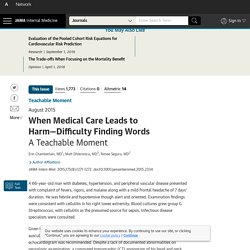
He was febrile and hypotensive though alert and oriented. Examination findings were consistent with cellulitis in his right lower extremity. Blood cultures grew group G Streptococcus, with cellulitis as the presumed source for sepsis. Infectious disease specialists were consulted. Susan's Story. When patients choose wisely: empowering patients with evidence to resist low-value care. Anneliese Synnot and David Synnot.
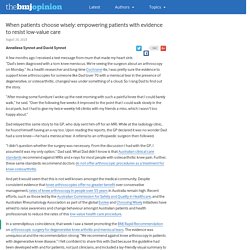
Status Iatrogenicus: Root Cause Analysis: Dig Deeper, or the Weed Will Keep Growing Back. In a recent JAMA Performance Improvement piece, the authors describe the case of a man who presented to the emergency department with dizziness.

He was sedated for an MRI, his history of OSA (obstructive sleep apnea) may have been glossed over, and he arrested in the radiology department. The subsequent "root cause analysis" traced the untoward outcome to a failure to recognize the OSA and the adverse effects that may follow sedation of a patient with this diagnosis. When a Medical “Cure” Makes Things Much, Much Worse.
Keiko Yamaguchi’s troubles began with diarrhea.

After a few weeks, her toes went numb. The numbness and weakness crept up her legs, to her hips, and her vision began to fail. That was in early 1967. By the end of 1968, Yamaguchi, just 22 years old, was blind and paralyzed from the waist down. She was one of more than 11,000 people in Japan, (with reported cases also occurring in Great Britain, Sweden, Mexico, India, Australia, and several other nations) who were struck by a mysterious epidemic between 1955 and 1970.
The illness usually started with bouts of diarrhea and vomiting. What was causing the outbreak? Other possible causes were considered and shot down. Lown Vignette Winner: What should the target blood pressure be? - Lown Institute. What should the target blood pressure be?

Deepa Ramadurai, MD David Tanaka, MD University of Colorado Internal Medicine Residency Training Program, Aurora, CO. Management of Patients With Febrile Neutropenia. A woman in her 30s with stage 2A breast cancer came to the emergency department after recording a temperature of 38.6°C at home.
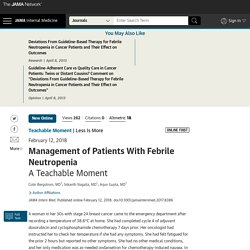
She had completed cycle 4 of adjuvant doxorubicin and cyclophosphamide chemotherapy 7 days prior. Her oncologist had instructed her to check her temperature if she had any symptoms. She had felt fatigued for the prior 2 hours but reported no other symptoms. Tales of Survival: Do No Harm. By Derek Moriyama, MD He stared blankly at the ceiling.
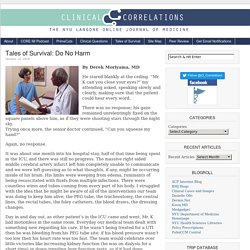
“Mr. K can you close your eyes?” My attending asked, speaking slowly and clearly, making sure that the patient could hear every word. There was no response; his gaze remained unrelentingly fixed on the square panels above him, as if they were shooting stars through the night sky. A Patient, Minimally Disruptive Medicine, and a Palliative Care Program – Minimally Disruptive Medicine. Submitted by Paige Organick, Nataly Suarez, M.D., Anjali Thota and Bjorg Thorsteinsdottir, M.D.
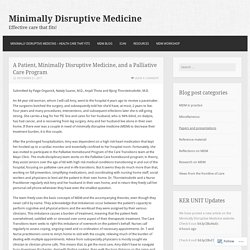
An 84 year old woman, whom I will call Amy, went to the hospital 4 years ago to receive a pacemaker. The surgeons botched the surgery, and subsequently told her she’d have, at most, 2 years to live. Four years and many procedures, interventions, and subsequent infections later she is still going strong. Treating-to-Target - Common Ground. DRUG BUST by Alan Cassels • The people’s briefing note on prescription drugs For most people, taking drugs for high blood pressure seems like the right thing to do, but is it?

That’s the question I’m asking as I look ever more closely at what the research says about the wisdom of feeding pharmaceuticals to otherwise healthy people who have nothing other than a “high” blood pressure reading. Why I Almost Fired My Doctor - The New York Times. Acne & Antibiotics: Why I Regret Not Speaking with my Doctor - Choosing Wisely Canada. Patient Stories by: Samantha Relich for Choosing Wisely Canada For a long time, when Lauren looked in the mirror all she wanted was her acne gone.

By the time she was in the 11th grade she had exhausted all her options for topical over-the-counter treatments. Missed Opportunities for Deprescription. Story From the Front Lines An 88-year-old man presented to the emergency department with episodic light-headedness and dizziness of 4 days’ duration without vertigo. He had experienced these symptoms 3 years earlier during an episode of hypoglycemia. Man evicted from hospital for blocking bed for two years. A hospital applied for a court order to remove a patient who had occupied a bed "unnecessarily" for more than two years. The man, who has not been named by the hospital, had refused to leave the James Paget University Hospital in Norfolk. The hospital said he had been "fit for discharge" and had been offered appropriate accommodation. It said the decision to go to court was a last resort and "not taken lightly". The man, from Suffolk, had been at the hospital in Gorleston, near Great Yarmouth, since August 2014.
Underactive thyroid may be overdiagnosed, overtreated in the elderly. Older people may too often be diagnosed with an underactive thyroid and prescribed thyroid hormones, which can cause new troubles and expenses without improving their lives, researchers say. A recent case study provides a snapshot of the larger problem, the authors write in JAMA Internal Medicine.
Just 1 percent to 2 percent of people have hypothyroidism, in which their thyroid gland is underactive and requires treatment, coauthor Dr. Juan P. Brito of the Mayo Clinic in Rochester, Minnesota, told Reuters Health. But about 15 percent of people have "subclinical hypothyroidism" - hormone levels that are between the healthy range and the diagnostic cutoff for hypothyroidism and that cause few or no symptoms. Massive Rectal Hemorrhage After Prostate Biopsy: A Teachable Moment. Status Iatrogenicus: Medical Decision Making as a "Patient": Pregnancy Leads to A Trip Down The Rabbit Hole - A Personal Story. My wife is pregnant. Wanting to be a supportive spouse, I attended the first prenatal visit to see one member of her team of midwives. (Being a "minimalist" I was, like my wife, fond of the idea of not unnecessarily "medicalizing" the [usually] natural act of labor and birth.)
I realized during that first visit that understanding the intricacies of medical decision making can be a double-edged sword when dealing with practitioners, especially outside of one's specialty. If ignorance is bliss, 'tis folly to be wise, it is said. Status Iatrogenicus: The Enemy of Good is Better: Maximizing versus Satisficing in Clinical Medicine. Recently I was called to admit a little old lady with a digoxin overdose who had symptomatic bradycardia. She was in her 70s, had Alzheimer's disease (AD) and a medication list that would not print on one page.
I immediately thought, what benefit does digoxin have that justifies even the occasional admission for toxicity? That's a good question in its own right, but consider a partial list of her other medications:pantoprazolelisinoprilgabapentinraloxifeneestradioldonepezillabetololfurosemideglipizidefenofibratememantinesitagliptinspironolactoneamlodipinealprazolamaspirin One certainly must wonder what goals her providers are trying to achieve with these and indubitably some other medications which aren't listed.
Helping to reduce the burden of taking 83 pills a week – A nurse’s perspective – Minimally Disruptive Medicine. I’m healthy, please leave me alone. Intensive Glycemic Control in Type 2 Diabetes Mellitus—A Balancing Act of Latent Benefit and Avoidable Harm: A Teachable Moment. This Teachable Moment provides an example of how patient-centered care and shared decision-making require a comprehensive and transparent discussion between patient and physician of known risks, benefits, costs, and burden of available and reasonable treatment options. Article InformationCorresponding Author: Rozalina G.
Competing Mortality in Cancer Screening: A Teachable Moment. Learning to Say No to Dialysis. Diabetes in an older woman living in a long-term care residence. “Why Test For a Condition You Don’t Intend to Treat?” – A Choosing Wisely Patient Story. Why minimally disruptive medicine matters by Kerri Sparling. Listen To Your Patient And They Will Tell You The Problem - A True Story - Mind The Gap. Readers of Mind the Gap, I apologize for my absence in recent months. Richard Lehman on prescribing Spironolactone. The liveliest e-mail streams I have ever encountered are the ones which are currently coming out of the Overdiagnosis Group, set up by Margaret McCartney last year.
The group is now a standing body within the Royal College of General Practitioners and most of its members are working GPs. Older Patients With Cardiac Devices. The Need for Better Patient–Doctor Conversations. I-was-diagnosed-with-breast-cancer-did-nothing. In August of 2007 I went to the doctor for a checkup. A Pacemaker Wrecks a Family's Life. Photo. Overdiagnosis of Gestational Diabetes Mellitus in Pregnant Woman: A Case Report. [Unfavorable outcome of aggressive lowering of high blood pressure. Case report]. Glucose Control in Older Adults With Diabetes Mellitus—More Harm Than Good?
Ultrasound and Fury: One Mother's Ordeal. Why I’m Opting out of Mammography. Unintended Influence: When Our Words Mean More Than We Think. Which medical tests are worth doing? Polypharmacy: National Prescribing Service Newsletter. B.C. parents battle for baby’s life. Mind the Outcomes. Overtreatment Is Taking a Harmful Toll. How the CA-125 became a $50,000 blood test. Fran's story. Rational test ordering in family medicine. How heartburn caused a patient to lose her left leg. Cardiac testing in an asymptomatic 42-year-old man - CMA. No medicine is sometimes the best medicine.